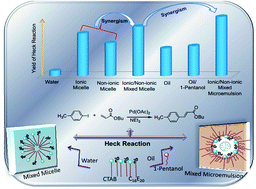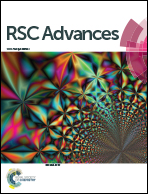Synergistic interactions of surfactant blends in aqueous medium are reciprocated in non-polar medium with improved efficacy as a nanoreactor†
Abstract
Organized assemblies in aqueous and non-aqueous media based on mixed surfactants are one of the desired areas for experimental studies and carrying out chemical reactions due to synergistic performance and efficient solvents for various substrates. In this report, a model C–C cross coupling Heck reaction between n-butyl acrylate and 4-iodo-toluene is performed both in micelles and water/oil microemulsion systems as reaction media using a similar set of surfactants, [cetyltrimethylammonium bromide (CTAB) and polyoxyethylene (20) cetyl ether (C16E20)], in their single and mixed states for the first time. In order to explain the possible location and mechanism of reaction in these media, multitechnique approaches are employed to understand the mutual interactions between surfactant(s) and other constituents in pure and mixed states at air–water as well as oil–water interfaces. A synergistic interaction is evidenced experimentally for a mixed CTAB/C16E20 micellar system, which is also supported by theoretical calculations using density functional theory (DFT). The yield of Heck product in different media follows the order water < pure micelle < mixed micelle, which indicates a significant role of the confined environment of the aggregated systems. Further, mixed microemulsions including constituents of the formulations 1-pentanol and n-heptane or n-decane are explored as nanoreactors for carrying out such a reaction. Reaction yield in mixed water-in-oil (w/o) systems as a function of different hydration levels has been correlated with formation and microstructural characteristics of these systems. Further, mixed microemulsions at lower hydration levels produce synergistic performance compared to micelles and individual constituents in terms of reaction yield. These results reveal that the reaction occurs in neither the water nor oil domain, evidently in the micelle/water pseudo-phase and at the palisade layer of the oil/water interface of microemulsions. Moreover, reaction yields in the studied media are rationalized in terms of interaction parameters, spontaneity of micellization, interfacial population of 1-pentanol, and spontaneity of formation of w/o microemulsions.


 Please wait while we load your content...
Please wait while we load your content...